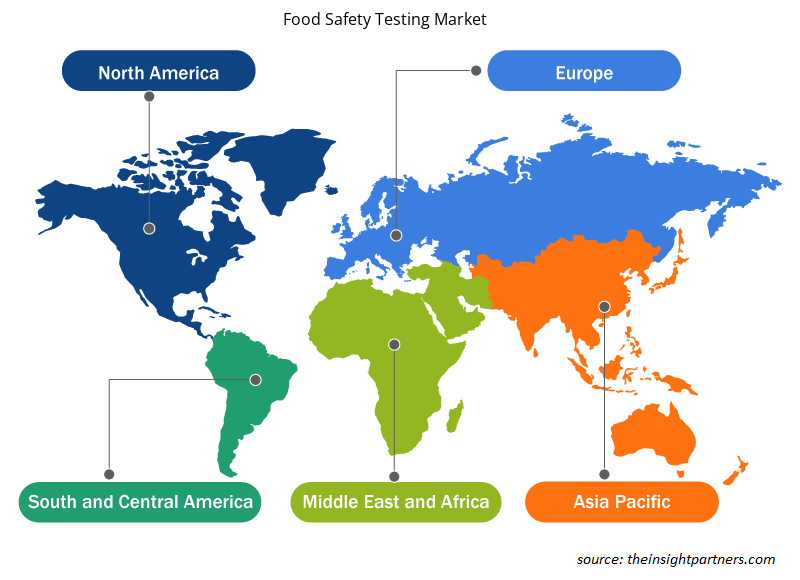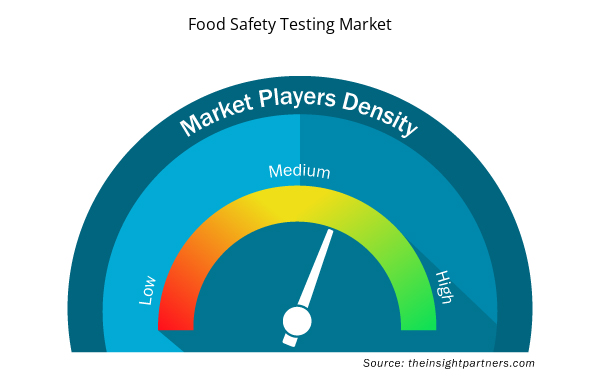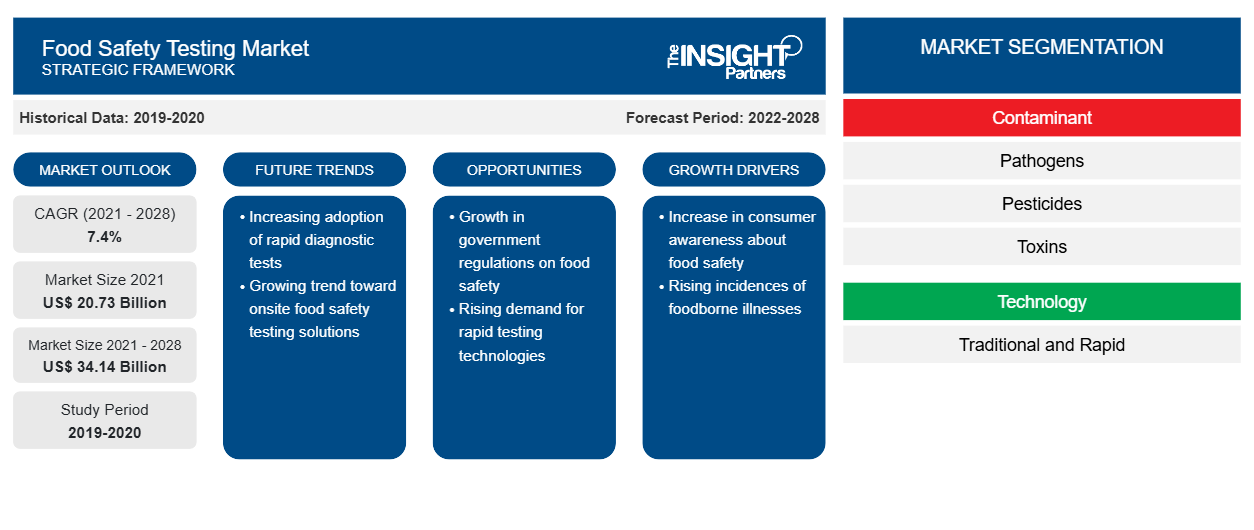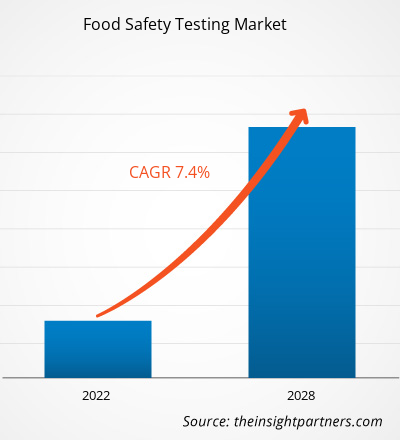2021 年食品安全检测市场价值为 207.334 亿美元,预计到 2028 年将达到 341.425 亿美元;预计 2021 年至 2028 年的复合年增长率为 7.4%。
食品安全检测是对食品及其成分的科学分析,以查找有关各种特性(例如物理化学性质、成分和结构)的信息。这些信息用于确定产品的食用安全性。食源性疾病的流行率不断上升,要求对所有食品和饮料产品进行食品安全检测以防止健康危害,这促进了食品安全检测市场的增长。
根据世界卫生组织 (WHO) 发布的数据,不安全食品的消费每年导致全球 42 万人死亡和 6 亿例食源性疾病。食源性疾病是可以预防的;因此,许多组织和政府领导协调行动,在多个行业建立有弹性和强大的食品安全系统。此外,2018 年世界银行的一份报告估计,食源性疾病造成的生产力总损失造成的经济负担估计为每年 952 亿美元。因此,由于消费者对食品安全的认识和政府预防食源性疾病的努力,食品安全检测市场正在见证增长。
定制此报告以满足您的需求
您可以免费定制任何报告,包括本报告的部分内容、国家级分析、Excel 数据包,以及为初创企业和大学提供优惠和折扣
- 获取此报告的关键市场趋势。这个免费样品将包括数据分析,从市场趋势到估计和预测。
COVID-19 疫情对食品安全检测市场的影响
消费者意识是全球食品安全检测市场的主要驱动力之一。由于消费者和政府都注重消费品的安全和卫生,COVID-19 疫情对市场产生了积极影响。疫情期间,所有食品和饮料行业都面临挑战,因为 SARS-CoV-2 传染性极强,可能通过食物表面传播。肉类和家禽加工厂在病毒传播方面面临着独特的挑战,因为全球多家工厂的工人都被感染了。例如,美国卫生与公众服务部于 2020 年 7 月报告称,23 个州的 239 家工厂感染了 COVID-19。报告的病例总数为 16,233 例,其中 86 例死亡。此外,2020 年 11 月,中国报告称,进口自中国的冷冻猪肘样本在该国引发了一起新的 COVID-19 病例。食品行业此类 COVID-19 感染病例引起了消费者和政府的担忧,从而推动了对食品安全检测的需求,以减轻健康风险。
市场洞察
食源性疾病暴发
食源性疾病具有毒性或传染性。它们可能是由化学物质、寄生虫、病毒通过受污染的水或食物进入人体引起的。食源性病原体可导致使人衰弱的感染,如脑膜炎或严重腹泻。在某些情况下,化学污染可导致长期疾病,如癌症,或短期疾病,如急性中毒。不安全食品的一些例子是含有海洋生物毒素的生贝类、被粪便污染的蔬菜和水果以及未煮熟的动物源食品。大肠杆菌、弯曲杆菌和沙门氏菌是最常见的食源性病原体,每年影响全球数百万人并导致致命或严重后果。食源性疾病的一些症状是腹泻、腹痛、呕吐、恶心、头痛和发烧。此外,李斯特菌感染会导致新生儿死亡或孕妇流产。尽管这种疾病的几率相对较低,但李斯特菌的致死率使其成为最严重的食源性感染之一。霍乱弧菌通过受污染的食物或水感染人类。其症状可能包括严重脱水、大量水样腹泻、呕吐、腹痛,并可能导致死亡。各种海鲜、小米粥、蔬菜和大米都与霍乱爆发有关。因此,对食品安全检测的需求正在增加,以防止食源性疾病的发生。
污染物洞察
根据污染物,食品安全检测市场细分为病原体、农药、毒素、转基因生物等。病原体部分在 2020 年占据了最大的市场份额,而转基因生物部分预计在预测期内将在市场上实现最高的复合年增长率。病原体检测是为了消除或减少食源性疾病的发病率。消除病原体被认为非常重要,因此在食品生产的每个步骤中都要实施检测过程,以确保食品安全和卫生。可能导致食源性疾病的一些最常见病原体是大肠杆菌、李斯特菌和沙门氏菌。病原体检测可以使用传统技术或新技术进行。传统技术使用传统的细胞培养标准,而新技术包括基于激光或光谱的诊断。由于病原体是食源性疾病的最常见原因之一,因此病原体部分在食品安全检测市场中占有最大的市场份额。此外,由于食品和饮料行业的增长,预计该细分市场的市场在预测期内将增长。
技术洞察
根据技术,食品安全检测市场分为传统和快速两类。快速部分在 2020 年占据了更大的市场份额,预计在预测期内,同一部分将在市场上实现更高的复合年增长率。由于对该服务的需求很高,主要市场参与者正在快速测试中推出创新产品。例如,2009 年,bioMérieux, Inc. 推出了 TEMPO,这是一种用于计数食品中微生物的自动化系统。该自动化系统使用微型卡消除了最大可能数 (MPN) 方法中涉及的繁琐手动步骤。因此,自动化测试提供了简单的可追溯性和高吞吐量,并且它也是手动测试的经济高效的替代方案。此外,该公司还推出了用于食源性病原体检测的重组噬菌体技术,这缩短了细菌在可检测水平上生长的时间。这种快速测试在食品制造商节省成本方面非常有用,因为库存批次的等待时间大大缩短。因此,预计快速测试的多重优势将在预测期内推动该领域的市场增长。
食物类型洞察
根据食品类型,食品安全检测市场细分为肉类、家禽和海鲜产品;乳制品;谷物和谷物;加工食品;水果和蔬菜;以及其他。肉类、家禽和海鲜产品部分在 2020 年占据了最大的市场份额,而水果和蔬菜部分预计在预测期内将在市场上实现最高的复合年增长率。肉类、家禽和海鲜产品测试包括污染物测试以及食品掺假测试,其中一种肉类掺假其他肉类。产品可以进行灰分、脂肪、水分、蛋白质/氮、重金属、农药、抗生素和药物、盐、氯化物以及硝酸盐和亚硝酸盐的测试。考虑到这些产品的保质期和性质,肉类产品最容易受到污染或有缺陷。因此,所有国家都必须对这些产品进行测试。由于全球肉类、家禽和海鲜产品消费量的增加,预计该细分市场的市场将增长。
食品安全检测市场中的一些参与者包括 SGS SA、Eurofins Scientific、Intertek Group Plc、TÜV SÜD、AES Laboratories Pvt. Ltd.、TÜV NORD GROUP.、Bureau Veritas、ALS Limited、NEOGEN Corporation 和 AsureQuality。这些公司为市场提供广泛的产品组合。这些公司在发展中地区都有业务,这为食品安全检测市场的增长提供了有利可图的机会。市场参与者正在开发高质量和创新的产品以满足客户的需求。
报告亮点
- 食品安全检测市场的渐进式行业趋势可帮助参与者制定有效的长期战略
- 发达市场和发展中市场采用的业务增长战略
- 2019年至2028年食品安全检测市场定量分析
- 全球食品安全检测需求估计
- 波特的五力分析说明了行业中买家和供应商的效力
- 了解竞争市场状况的最新发展
- 市场趋势和前景以及推动和抑制食品安全检测市场增长的因素
- 通过强调支撑商业利益的市场策略来协助决策过程,从而促进市场增长
- 各节点食品安全检测市场规模
- 市场详细概述和细分,以及食品安全检测行业动态
- 各地区食品安全检测市场规模及增长潜力分析
食品安全检测市场区域洞察
Insight Partners 的分析师已详细解释了预测期内影响食品安全检测市场的区域趋势和因素。本节还讨论了北美、欧洲、亚太地区、中东和非洲以及南美和中美洲的食品安全检测市场细分和地理位置。

- 获取食品安全检测市场的区域特定数据
食品安全检测市场报告范围
| 报告属性 | 细节 |
|---|---|
| 2021 年市场规模 | 207.3亿美元 |
| 2028 年市场规模 | 341.4亿美元 |
| 全球复合年增长率(2021 - 2028) | 7.4% |
| 史料 | 2019-2020 |
| 预测期 | 2022-2028 |
| 涵盖的领域 | 按污染物
|
| 覆盖地区和国家 | 北美
|
| 市场领导者和主要公司简介 |
|
食品安全检测市场参与者密度:了解其对业务动态的影响
食品安全检测市场正在快速增长,这得益于终端用户需求的不断增长,而这些需求又源于消费者偏好的不断变化、技术进步以及对产品优势的认识不断提高等因素。随着需求的增加,企业正在扩大其产品范围,进行创新以满足消费者的需求,并利用新兴趋势,从而进一步推动市场增长。
市场参与者密度是指在特定市场或行业内运营的企业或公司的分布情况。它表明在给定市场空间中,相对于其规模或总市场价值,有多少竞争对手(市场参与者)存在。
在食品安全检测市场运营的主要公司有:
- 瑞士通用公证行
- 欧陆科技
- 天祥集团
- TÜV南德意志集团
- AES 实验室私人有限公司
免责声明:上面列出的公司没有按照任何特定顺序排列。

- 了解食品安全检测市场主要参与者概况
食品安全检测市场 – 按污染物分类
- 病原体
- 沙门氏菌
- 大肠杆菌
- 李斯特菌
- 其他的
- 农药
- 毒素
- 转基因生物
- 其他的
食品安全检测市场 – 按技术分类
- 传统的
- 迅速的
- PCR 检测
- 基于免疫测定的检测
- 其他的
食品安全检测市场 – 按食品类型
- 肉类、家禽和海鲜产品
- 乳制品
- 谷物和谷类
- 加工食品
- 水果和蔬菜
- 其他的
公司简介
- 瑞士通用公证行
- 欧陆科技
- 天祥集团
- TÜV南德意志集团
- AES 实验室私人有限公司
- TÜV NORD 集团。
- 必维国际检验集团
- 艾力士有限公司
- Neogen 公司
- 品质保证
- 历史分析(2 年)、基准年、预测(7 年)及复合年增长率
- PEST 和 SWOT 分析
- 市场规模价值/数量 - 全球、区域、国家
- 行业和竞争格局
- Excel 数据集



Report Coverage
Revenue forecast, Company Analysis, Industry landscape, Growth factors, and Trends

Segment Covered
This text is related
to segments covered.

Regional Scope
North America, Europe, Asia Pacific, Middle East & Africa, South & Central America

Country Scope
This text is related
to country scope.
常见问题
Based on technology, the food safety testing market is bifurcated into traditional and rapid. The rapid segment accounted for a larger market share in 2020. Rapid tests prove to be useful in terms of cost saving for food manufacturers as the waiting period for batches in inventory is significantly reduced. Thus, the multiple benefits of rapid testing is expected to fuel the market growth for this segment during the forecast period.
In 2020, China held the largest market share in the global food safety testing market. China is the most populated country in the world and is a major hub for food and beverages industry. The country annually imports and exports large quantities of food products to different parts of the world. As per data published by the International Trade Administration, U.S. Department of Commerce, the food and beverage sector of China reached US$ 595 billion in 2019 in terms of consumption. Moreover, considering the aggressive development of China and rising middle class population with high disposable income, numerous food brands are attempting to enter the market in the country. Therefore, the food trade as well as consumption in the country is growing at a high pace resulting in positive impact for food safety testing, as testing in the country is becoming increasingly stringent for food processing.
The pathogens segment accounted for the largest market share in 2020. Since pathogens are one of the most common reasons for foodborne illnesses, the pathogen segment holds the largest market share in the food safety testing market. Also, the market for this segment is expected to grow at a high pace during the forecast period due to the growth of the food & beverages industry.
The major players operating in the global food safety testing market are SGS SA, Eurofins Scientific, Intertek Group Plc, TÃœV SÃœD, AES Laboratories Pvt. Ltd., TÃœV NORD GROUP., Bureau Veritas, ALS Limited, NEOGEN Corporation, and AsureQuality.
Foodborne illnesses are toxic or infectious. They can be caused by the chemical substances, parasites, viruses entering the body through contaminated water or food. In some cases chemical contamination can cause long-term diseases, such as cancer, or short-term illness, such as acute poisoning. A few examples of unsafe food are raw shellfish containing marine biotoxins, vegetables and fruits contaminated with feces, and uncooked foods of animal origin. E. Coli, campylobacter, and salmonella are among the most common foodborne pathogens that affect millions of people worldwide annually and result in fatal or severe outcomes. Moreover, listeria infection leads to death of newborn babies or miscarriages in pregnant women. Although the chances of this disease are relatively low, the fatality of listeria makes it one of the most serious foodborne infections. Vibrio cholera infects people through contaminated food or water. Various types of seafood, millet gruel, vegetables, and rice have been implicated in cholera outbreaks. Therefore, the demand for food safety testing is increasing to prevent the incidence of foodborne illnesses.
In 2020, North America held the largest share of the market. The Centre for Disease Control and Prevention (CDC) has determined that one out of ten people fall sick due to foodborne illness each year in the US. The rising incidence of foodborne diseases has propelled the need for rapid testing, which is driving the market growth in North America. Additionally, enhanced detection and surveillance methods have fueled the food safety testing market growth in North America.
Trends and growth analysis reports related to Consumer Goods : READ MORE..
The List of Companies - Food Safety Testing Market
- SGS SA
- Eurofins Scientific
- INTERTEK GROUP PLC
- TÜV SÜD
- AES Laboratories Pvt. Ltd.
- TÜV NORD GROUP.
- BUREAU VERITAS
- ALS Limited
- NEOGEN Corporation
- AsureQuality
The Insight Partners performs research in 4 major stages: Data Collection & Secondary Research, Primary Research, Data Analysis and Data Triangulation & Final Review.
- Data Collection and Secondary Research:
As a market research and consulting firm operating from a decade, we have published and advised several client across the globe. First step for any study will start with an assessment of currently available data and insights from existing reports. Further, historical and current market information is collected from Investor Presentations, Annual Reports, SEC Filings, etc., and other information related to company’s performance and market positioning are gathered from Paid Databases (Factiva, Hoovers, and Reuters) and various other publications available in public domain.
Several associations trade associates, technical forums, institutes, societies and organization are accessed to gain technical as well as market related insights through their publications such as research papers, blogs and press releases related to the studies are referred to get cues about the market. Further, white papers, journals, magazines, and other news articles published in last 3 years are scrutinized and analyzed to understand the current market trends.
- Primary Research:
The primarily interview analysis comprise of data obtained from industry participants interview and answers to survey questions gathered by in-house primary team.
For primary research, interviews are conducted with industry experts/CEOs/Marketing Managers/VPs/Subject Matter Experts from both demand and supply side to get a 360-degree view of the market. The primary team conducts several interviews based on the complexity of the markets to understand the various market trends and dynamics which makes research more credible and precise.
A typical research interview fulfils the following functions:
- Provides first-hand information on the market size, market trends, growth trends, competitive landscape, and outlook
- Validates and strengthens in-house secondary research findings
- Develops the analysis team’s expertise and market understanding
Primary research involves email interactions and telephone interviews for each market, category, segment, and sub-segment across geographies. The participants who typically take part in such a process include, but are not limited to:
- Industry participants: VPs, business development managers, market intelligence managers and national sales managers
- Outside experts: Valuation experts, research analysts and key opinion leaders specializing in the electronics and semiconductor industry.
Below is the breakup of our primary respondents by company, designation, and region:

Once we receive the confirmation from primary research sources or primary respondents, we finalize the base year market estimation and forecast the data as per the macroeconomic and microeconomic factors assessed during data collection.
- Data Analysis:
Once data is validated through both secondary as well as primary respondents, we finalize the market estimations by hypothesis formulation and factor analysis at regional and country level.
- Macro-Economic Factor Analysis:
We analyse macroeconomic indicators such the gross domestic product (GDP), increase in the demand for goods and services across industries, technological advancement, regional economic growth, governmental policies, the influence of COVID-19, PEST analysis, and other aspects. This analysis aids in setting benchmarks for various nations/regions and approximating market splits. Additionally, the general trend of the aforementioned components aid in determining the market's development possibilities.
- Country Level Data:
Various factors that are especially aligned to the country are taken into account to determine the market size for a certain area and country, including the presence of vendors, such as headquarters and offices, the country's GDP, demand patterns, and industry growth. To comprehend the market dynamics for the nation, a number of growth variables, inhibitors, application areas, and current market trends are researched. The aforementioned elements aid in determining the country's overall market's growth potential.
- Company Profile:
The “Table of Contents” is formulated by listing and analyzing more than 25 - 30 companies operating in the market ecosystem across geographies. However, we profile only 10 companies as a standard practice in our syndicate reports. These 10 companies comprise leading, emerging, and regional players. Nonetheless, our analysis is not restricted to the 10 listed companies, we also analyze other companies present in the market to develop a holistic view and understand the prevailing trends. The “Company Profiles” section in the report covers key facts, business description, products & services, financial information, SWOT analysis, and key developments. The financial information presented is extracted from the annual reports and official documents of the publicly listed companies. Upon collecting the information for the sections of respective companies, we verify them via various primary sources and then compile the data in respective company profiles. The company level information helps us in deriving the base number as well as in forecasting the market size.
- Developing Base Number:
Aggregation of sales statistics (2020-2022) and macro-economic factor, and other secondary and primary research insights are utilized to arrive at base number and related market shares for 2022. The data gaps are identified in this step and relevant market data is analyzed, collected from paid primary interviews or databases. On finalizing the base year market size, forecasts are developed on the basis of macro-economic, industry and market growth factors and company level analysis.
- Data Triangulation and Final Review:
The market findings and base year market size calculations are validated from supply as well as demand side. Demand side validations are based on macro-economic factor analysis and benchmarks for respective regions and countries. In case of supply side validations, revenues of major companies are estimated (in case not available) based on industry benchmark, approximate number of employees, product portfolio, and primary interviews revenues are gathered. Further revenue from target product/service segment is assessed to avoid overshooting of market statistics. In case of heavy deviations between supply and demand side values, all thes steps are repeated to achieve synchronization.
We follow an iterative model, wherein we share our research findings with Subject Matter Experts (SME’s) and Key Opinion Leaders (KOLs) until consensus view of the market is not formulated – this model negates any drastic deviation in the opinions of experts. Only validated and universally acceptable research findings are quoted in our reports.
We have important check points that we use to validate our research findings – which we call – data triangulation, where we validate the information, we generate from secondary sources with primary interviews and then we re-validate with our internal data bases and Subject matter experts. This comprehensive model enables us to deliver high quality, reliable data in shortest possible time.


 获取此报告的免费样本
获取此报告的免费样本